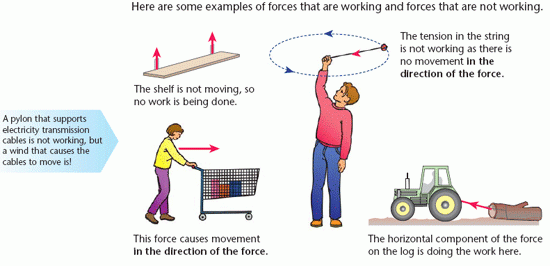Working
Every event requires work to make it happen. Even if you relax and try to do nothing, your body is working just to keep you alive. Any force that causes movement is doing work. Pushing a supermarket trolley is working, as is throwing or kicking a ball. However, holding some weights above your head is not working; it may cause your arms to ache, but the force on the weights is not causing any movement!
How much work a force does depends on:
- the size of the force
- the direction of movement
- the distance that an object moves.
The work done by a force that causes movement is defined as:
work = average force × distance moved in the direction of the force
W = F × s
Work is measured in joules (J) where 1 joule is the work done when a force
of 1 N moves its point of application 1 m in the direction of the force.
The phrase, 'distance moved in the direction of the force', is used here instead of ‘displacement’ to emphasise that the force and displacement it causes are measured in the same direction.

In the case of the stone being whirled in a horizontal circle, the stone’s velocity is always at right angles to the force that maintains the motion, so the force is not working.
Although the force pulling the log and the movement it causes are not in the same direction, the force on the log has a component in the same direction as the log’s movement. In calculating the work done the horizontal component of the force is multiplied by the horizontal distance moved by the log.
In circular motion, the direction of the velocity is along a tangent to the circle.
